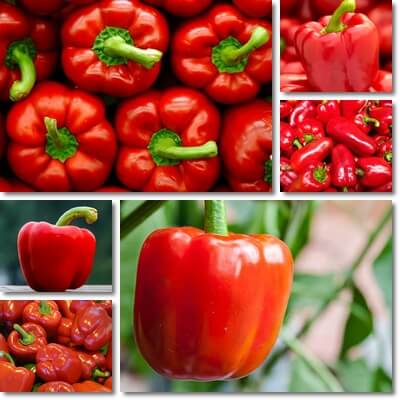The red bell pepper is a variety of bell pepper that ripens to a red color. It’s the sweetest of all varieties and a source of good nutrition. Red bell peppers are low in calories, fat and sugars, but a good source of vitamins B3, B6 and B9, manganese and potassium. They are especially rich in vitamins A and C, two essential micro-nutrients with benefits for the immune system, skin and eye health. Other benefits associated with consumption of the color variety include minor benefits for high blood pressure, cholesterol numbers, energy metabolism and more.
What does a red bell pepper look like?
Red bell peppers are bulky-looking, medium to large in size and hollow inside, with 3 or 4 lobes at the base (the end opposite to the stem). Initially green, they ripen to, you’ve guessed it: red! So you can say red bell peppers are just ripe green bell peppers. Both the skin and flesh are the same color. The skin looks shiny, almost waxy and is smooth to the touch. The peppers have a thick, meaty, crisp flesh. Inside, towards the stem, there is a white, spongy pulp to which dozens of roundish, flat, creamy white seeds are attached.

What does a red bell pepper taste like?
The red bell pepper is the sweetest of all bell pepper colors. It has thick, meaty, crisp red flesh with a pleasantly sweet taste and faint bitter flavors. Not fully ripe peppers may taste slightly more bitter: the greener they are, the more bitter; the redder, the sweeter. Being a bell pepper cultivar, it doesn’t contain any pungent capsaicinoid compounds, hence the sweet taste and lack of spiciness. Overall, it’s the variety that is best suited for eating raw, but also develops wonderful flavors when cooked, especially roasted.
Recipe ideas
Mediterranean style salads with tomatoes, cucumbers, onions, red bell peppers, feta cheese, olives and extravirgin olive oil are perfect if you’re looking for a simple, no-cook meal recipe. If you don’t have any time at all, wash your peppers and slice them, then just dip the slices into cream cheese, hummus, guacamole, a fried bean dip or even fish roe dip. One of the best and simplest red bell pepper recipes is roasted red bell peppers dipped in a crushed garlic, salt and water sauce (remember that the skins need to be peeled before eating).
If you don’t have stomach problems such as acid reflux or gastritis, then you can try a pureed onion and red bell pepper soup made from pureed roasted red bell peppers and onions, seasoned with salt, thyme, oregano and thickened with sour cream. You can also try some variations such as red bell pepper and zucchini, cauliflower, peas or carrot (pureed) soup – seasoned with salt and favorite herbs and thickened with sour cream. The particular color variety is great stuffed with heartier options such as pork or chicken sausages, ground turkey meat or beef or cheese. Lastly, for an Italian cuisine-inspired dish, try spaghetti with fried red bell peppers and beans, seasoned with salt, pepper and thyme.

Nutrition facts for 100 g red bell pepper (raw)
- Energetic value: 26-31 kilocalories/kcal
- Fat: 0.3 g
- Cholesterol: 0 mg
- Protein: 0.99 g
- Carbohydrates: 6 g
- Sugars: 4.2 g (glucose and fructose)
- Dietary fiber: 2.1 g (concentrated in the skin)
- Vitamin A (RAE): 157 micrograms/mcg from antioxidant beta-carotene (1624 mcg), alpha-carotene (20 mcg), beta-Cryptoxanthin (490 mcg)
- Other antioxidants without vitamin A activity: lutein, zeaxanthin (51 mcg)
- Vitamin B1: 0.054 mg
- Vitamin B2: 0.085 mg
- Vitamin B3: 0.979 mg
- Vitamin B5: 0.317 mg
- Vitamin B6: 0.291 mg
- Vitamin B9: 46 mcg
- Vitamin B12: 0 g (naturally occurs in animal foods)
- Choline: 5.6 mg
- Vitamin C: 127.7 mg
- Vitamin D: 0 mcg
- Vitamin E: 1.58 mcg (primarily in the form of alpha-tocopherol)
- Vitamin K: 4.9 mcg
- Calcium: 7 mg
- Copper: 0.017 mg
- Iron: 0.43 mg
- Magnesium: 12 mg
- Manganese: 0.112 mg
- Phosphorus: 26 mg
- Potassium: 211 mg
- Selenium: 0.01-0.03 mcg
- Sodium: 4 mg
- Zinc: 0.25 mg
Red bell pepper nutrition profile is fairly similar to that other colors, except for certain aspects of its vitamin content. For instance, it’s higher in vitamin A than both green and yellow varieties, providing 157 micrograms of pro-vitamin A carotenoid antioxidants for every 100 g (the body converts carotenoids into vitamin A). By comparison, green sweet peppers provide only 18 mcg of vitamin A per 100 g, while yellow ones only 10 mcg.
Red bell pepper vitamin C content is the second highest of all colors: 127.7 mg per 100 g. By comparison, green ones have 80.4 mg of vitamin C, while yellow ones are highest with 183.5 mg. Another interesting nutrition fact of red bell peppers is the vitamin K content: 4.9 micrograms per 100 g. To compare, green ones have 7.4 micrograms of the vitamin, while yellow ones may contain only trace amounts.
Lastly, red bell peppers are a good source of potassium (211 mg per 100 g), vitamin B3 (0.979 mg), vitamin B9 (46 mcg) and dietary fiber (2.1 g). They are low in sodium (only 4 mg per 100 g, trace amounts), carbs (6 g), sugar (4.2 g) and calories (between 26-31 kcal) and have almost no fat.
Red bell peppers health benefits
- Good food for losing weight: low in calories, fat, carbohydrates and sugar.
- Good food for digestion and constipation relief thanks to a good dietary fiber content.
- Antioxidant benefits from the carotenoid antioxidants beta-carotene, alpha-carotene, beta-Cryptoxanthin, lutein, zeaxanthin, vitamin C, manganese and trace amounts of copper and iron.
- Anti-inflammatory benefits from vitamins C and K.
- Vitamin C stimulates collagen production for skin elasticity and has anti-aging and anti-inflammatory benefits for the skin.
- Vitamin E acts as an antioxidant and protect skin from oxidative stress, as well as promotes wound healing.
- Vitamins B1, B2, B3, B5, B6 and B9 prevent skin inflammation and actively contribute to skin health.
- Immune-system boosting benefits from vitamins C and A.
- Benefits for eyesight and mucous membranes in the nose, mouth, throat, lungs and digestive system from vitamin A.
- Good food to eat for increasing iron absorption thanks to a high vitamin C content.
- Anti-anemia properties: vitamin C increases iron absorption, vitamin B6 helps with the synthesis of heme, a component of hemoglobin in red blood cells, while vitamin B9 helps make healthy red blood cells, helping combat fatigue and boosting energy levels.
- Good food to eat for hypertension: low in sodium and a good source of potassium for better blood pressure numbers.
- Minor benefits for cholesterol numbers thanks to a good dietary fiber content and vitamin B3.
What are the side effects of Red Bell Peppers?
What do red bell peppers do for the body if they’re bad for you? A lot of foods have the potential to elicit side effects, red bell peppers included. Eating too many at once can cause indigestion and associated symptoms such as an upset stomach, painful abdominal cramps, belly button pain, gas, loose stools and even diarrhea. Red bell peppers are also a bad food to eat for GERD, or acid reflux disease, and gastritis, causing heartburn, chest pain, regurgitation of stomach contents, stomach pain (belly button pain or pain in the upper right abdomen), burping, bloating and more.
One of the worst possible side effects include triggering an allergic reaction which can, in unfortunate situations, culminate in anaphylactic shock. Although not a common allergen, if you know or suspect you are allergic to red or other bell peppers, avoid them in all forms and preparations.
